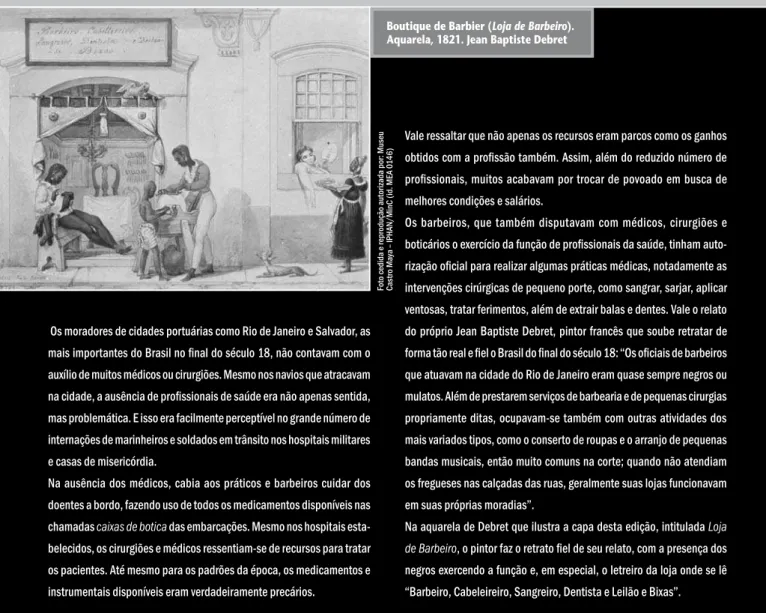NOSSA CAPA OUR JOURNAL COVER
J Bras Patol Med Lab • Volume 41 • Número 3 • Junho 2005 ISSN 1676-2444
The residents of port cities such as Rio de Janeiro and Salvador, the most
important ones at the end of the 18th century, did not count on the aid of
many doctors or surgeons. Even in the ships that arrived in the city, the
lack of health professionals was not only felt, but also troublesome, and
this was easily noticeable in the big number of sick sailors and soldiers in
the military and charitable hospitals.
In the absence of doctors, it fell to practitioners and barbers the care of
sick people on board, making use of all the drugs available in the so-called
pharmacy boxes of the ships. Even in established hospitals, doctors and
surgeons resented the lack of resources to treat patients. Drugs and
instruments available were really precarious even to the patterns of the
time. It is worth noticing that not only the resources were scarce, but so
were the fees obtained. Thus, besides the small number of professionals,
many of them moved away in search of better fees.
The barbers, who also disputed with doctors, surgeons and apothecaries
the exercise of the function of health professionals, had official permission
to perform some medical practices, mainly surgery interventions of minor
scale, such as bleeding, cutting for draining, applying cupping glasses,
treating wounds, besides extracting bullets and teeth. Important is the
report of Jean Baptiste Debret, the French painter who could very well
portray in a real and faithful way the late-18th-century Brazil: “The barbers
working in Rio de Janeiro were almost always blacks or mulattos. Besides
doing barber services or surgeries, they also took care of other activities
of different kinds, such as the mending of clothes and the arrangement
of small music bands, very common in the Court then; when practitioners
did not attend customers in the sidewalks, they usually installed shops
in their own homes.
In the watercolor by Debret, which illustrates the cover of this issue,
and is entitled Barber Shop, the artist painted the faithful portrait of his
report, with the presence of black people exerting their function and,
specially, with the detail of a store inscription, where one can read “Barber,
Hairdresser, Bleeder, Dentist, Auctions and Bixas”. Boutique de Barbier (Loja de Barbeiro).
Aquarela, 1821. Jean Baptiste Debret
Os moradores de cidades portuárias como Rio de Janeiro e Salvador, as
mais importantes do Brasil no final do século 18, não contavam com o
auxílio de muitos médicos ou cirurgiões. Mesmo nos navios que atracavam
na cidade, a ausência de profissionais de saúde era não apenas sentida,
mas problemática. E isso era facilmente perceptível no grande número de
internações de marinheiros e soldados em trânsito nos hospitais militares
e casas de misericórdia.
Na ausência dos médicos, cabia aos práticos e barbeiros cuidar dos
doentes a bordo, fazendo uso de todos os medicamentos disponíveis nas
chamadas caixas de botica das embarcações. Mesmo nos hospitais
esta-belecidos, os cirurgiões e médicos ressentiam-se de recursos para tratar
os pacientes. Até mesmo para os padrões da época, os medicamentos e
instrumentais disponíveis eram verdadeiramente precários.
Vale ressaltar que não apenas os recursos eram parcos como os ganhos
obtidos com a profissão também. Assim, além do reduzido número de
profissionais, muitos acabavam por trocar de povoado em busca de
melhores condições e salários.
Os barbeiros, que também disputavam com médicos, cirurgiões e
boticários o exercício da função de profissionais da saúde, tinham
auto-rização oficial para realizar algumas práticas médicas, notadamente as
intervenções cirúrgicas de pequeno porte, como sangrar, sarjar, aplicar
ventosas, tratar ferimentos, além de extrair balas e dentes. Vale o relato
do próprio Jean Baptiste Debret, pintor francês que soube retratar de
forma tão real e fiel o Brasil do final do século 18: “Os oficiais de barbeiros
que atuavam na cidade do Rio de Janeiro eram quase sempre negros ou
mulatos. Além de prestarem serviços de barbearia e de pequenas cirurgias
propriamente ditas, ocupavam-se também com outras atividades dos
mais variados tipos, como o conserto de roupas e o arranjo de pequenas
bandas musicais, então muito comuns na corte; quando não atendiam
os fregueses nas calçadas das ruas, geralmente suas lojas funcionavam
em suas próprias moradias”.
Na aquarela de Debret que ilustra a capa desta edição, intitulada Loja
de Barbeiro, o pintor faz o retrato fiel de seu relato, com a presença dos
negros exercendo a função e, em especial, o letreiro da loja onde se lê
“Barbeiro, Cabeleireiro, Sangreiro, Dentista e Leilão e Bixas”.
Fot
o cedida e r
epr
odução aut
or
izada por
: Museu
Cas
tr
o Ma
ya – IPHAN/MinC (id. MEA 0
1
